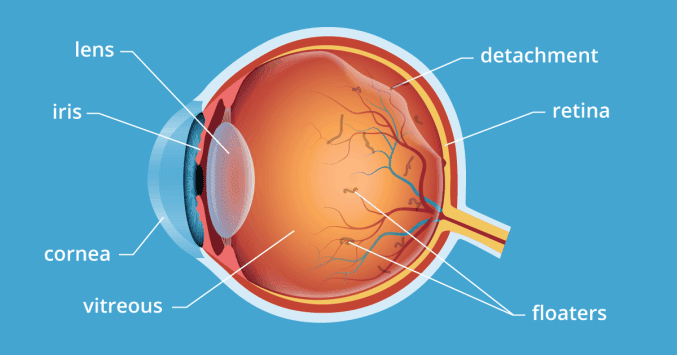
Those Aren’t Bugs, They’re Floaters!
May 8, 2019


Dark spots drifting through the line of sight. Pesky, gray, hair-like strands waving from the corner of vision. What are all these annoying things I’m seeing?! …most likely “floaters.”
What are floaters?
Floaters are clumps of fibers from the vitreous (gel-consistency substance) that have separated from the vitreous bulk, which fills about 80% of the eye. Everyone perceives their floaters slightly differently, however, the common description is black or gray dots, strands, or cobweb-like images. Floaters can even appear somewhat transparent. The spots move when the eye moves, which is why floaters drift or “float” away when you try to focus on them. People don’t see the actual floater, but rather a shadow of the particle on the retina. This explains why floaters are more obvious when looking at a bright sky or white wall with high contrast against the dark spot.
What causes floaters?

The vitreous is a clear, gel-like substance that fills the space between the retina and the lens in the eye. At birth, the vitreous and retina are attached. Over time, the gel begins to liquefy and becomes a watery mixture. During this natural, age-related process, vitreous fiber strands form small clumps that separate from the majority of the gel. These pieces of vitreous are commonly known as floaters.
The vitreous gel shrinks as it liquifies, which causes it to slowly pull away from the retina. Eventually, the vitreous will separate from the retina, which is called a posterior vitreous detachment (PVD). This is a very common, normal process, but it becomes dangerous when the vitreous does not have a clean separation from the retina. If the vitreous pulls too hard on the retina, it can take a piece of the retina with it, which is a retinal detachment. A retinal detachment is a serious condition, requiring prompt treatment to minimize the risk of permanent vision loss.
I see floaters – What should I do?
Call an eye doctor if you notice any of the following:
– Sudden onset of new floaters
– Large amount of floaters
– Flashes of light
– Darkening of vision or missing areas of vision
– Eye pain with floaters
In the minority of cases, floaters can be an indication of something more serious such as a detached retina, bleeding in the eye, or inflammation (swelling) in the eye. Certain types of migraine headaches can also cause a different form of eye floaters.
Is there a treatment for floaters?
Time is the best treatment for floaters. Within several months of first noticing a floater, the brain may adapt to the floater and completely ignore it. This is why you may not see your floaters for a long time (until we begin talking about floaters, of course). Sometimes the little pieces of vitreous can settle to the bottom of the eye due to gravity, which keeps them below the line of sight.
Some eye surgeons will perform a laser procedure or remove the entire vitreous as a treatment for floaters. These are both risky surgeries and have complications of their own. A vitrectomy (removing the vitreous and replacing it with saline or a bubble of gas or oil) is guaranteed to expedite cataract formation and increases the chances of a surgical-induced retinal detachment. Since the risks outweigh the benefit, neither of these procedures are commonly performed to electively remove floaters.
Floaters are usually just a nuisance versus anything harmful; However, the only way to be sure is by seeing an eye doctor for a dilated eye exam, especially if experiencing any out of the ordinary symptoms previously listed. If you’re unsure, give us a call – we are happy to see you!